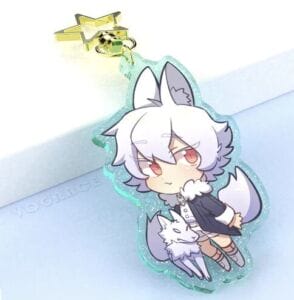Making sticker-adorned acrylic keychains is an enjoyable and imaginative do-it-yourself hobby suitable for people of all ages. These customized keychains can give your keys, purses, or presents a special touch. Even novices can complete the task because it is simple and requires little in the way of supplies.

A range of stickers, from vibrant patterns to more intricate designs, is available to suit your style. This instruction will help you ensure that your keychains turn out nicely and last long.
With simple materials and a little imagination, you can create fashionable and functional bespoke acrylic keychains. This method offers countless personalization options, and you can make an essential keychain or a more intricate design.
Materials Needed
You’ll need a few supplies and tools to create acrylic keychains with stickers. The following is a list of all the necessary items, along with a brief explanation of their respective uses:
- Acrylic Blanks: These are the pieces of transparent or coloured acrylic that serve as your keychain’s foundation. They offer a strong and fashionable base for your design and are available in various shapes and sizes.
- Stickers: To customize your keychains with designs, you must use high-quality stickers. Select stickers with designs that complement your theme or style and are the right size for your acrylic blanks.
- Hardware for keychains: This category comprises jump rings and key rings. Jump rings join the acrylic blank to the key ring, and the critical ring facilitates attaching the keychain to your bag or keys.
- Cutting Tools: To ensure your stickers fit the acrylic blanks properly, trim them with sharp scissors or a craft knife. Neat-cutting guarantees a professional appearance.
- Cleaning Cloths: The acrylic blanks are cleaned with gentle, lint-free cloths before sticker application. For optimal sticker adhesion, ensure the surface is free of dust, grease, and fingerprints.
- Rubbing alcohol: A mild cleanser that is used on acrylic blanks to get rid of any leftovers. It guarantees that the sticker surface is clean.
Each of these supplies and equipment is essential to the keychain-making process and helps ensure that the final creation is elegant and robust.
Step-by-Step Guide
Set Up Your Work Area
Making acrylic keychains with stickers is essential to keeping your workspace tidy and orderly. A neat workspace will make it easier to track all the supplies and equipment you need. Place a protective mat or cloth to shield the acrylic blanks from scratches.
Assemble all required equipment, such as sealants, cleaning cloths, tweezers, and scissors. Keeping everything close at hand will expedite the procedure and lessen the possibility of losing tiny objects like keychain hardware or stickers.
Choose and Get Ready for Stickers
Selecting the appropriate stickers is crucial for a keychain project’s success. Seek out premium stickers that fit your acrylic blanks precisely in size. Stickers might have simple, beautiful designs or bright, vivid images.
Select your stickers and then carefully cut or trim them to the correct size and shape to suit the acrylic blanks. Accuracy is essential here because any extra sticker material could result in peeling or uneven edges. Clean cuts can be obtained using a craft knife or a sharp pair of scissors.
Make the acrylic blanks clean.
For optimal adherence, the acrylic blanks must be cleaned before stickers are applied. If the surface has oil, dust, or fingerprints, the stickers may not attach correctly.
Wipe the acrylic blanks with a soft, lint-free cloth and a mild cleanser (rubbing alcohol, for example). Make sure the surface is arid before proceeding to the following stage. This easy prep work can significantly impact your keychain’s durability and final look.
Apply the stickers
It takes patience and delicacy to apply the stickers smoothly. Peel the sticker off its backing carefully to start. Use tweezers to handle the sticker and avoid fingerprints and smudges.
After aligning the sticker with the acrylic blank, press the sticker down gradually, starting from one end and moving towards the other. This technique aids in preventing wrinkles and air bubbles. If bubbles do form, use a flat instrument or a soft cloth to press them outward, starting in the middle gently.
Seal the Stickers
Sealing the stickers is an optional step that might improve the toughness and longevity of your keychain. A sealer can shield the sticker against wear and tear, water damage, and scratches. Sealants come in various forms, including Mod Podge, epoxy glue, and clear acrylic spray.
Apply the sealant evenly, following the manufacturer’s directions. Let the sealant fully cure before interacting with the keychain. This step is helpful if you want to give the keychain as a present or use it frequently.
Attach Hardware to Keychain
The keychain hardware needs to be attached as the last step. Acrylic blanks typically include a pre-drilled hole to connect the hardware. Attach the acrylic piece to the keychain ring using a tiny jump ring.
Using pliers to open the jump ring, insert it through the acrylic hole and then the keychain ring. Close the jump ring firmly to make sure it doesn’t come apart. Before closing it, glue the jump ring for extra security. This will guarantee that, even with frequent use, the keychain hardware remains securely fastened.
Conclusion
Making a customized acrylic keychain with stickers is an exciting and artistic approach to creating individual accessories. By carefully choosing your stickers, getting your acrylic keychains ready, and applying your stickers correctly, you can look professional and polished. Your custom keychains will be distinctive with vivid and original patterns, whether for presents or personal use.
FAQ’s
Can I apply any sticker?
Stickers meant for smooth surfaces will help acrylic keychains look their best. Given their robust adhesive strength and longevity, vinyl stickers are sometimes advised. Steer clear of paper stickers since they could easily rip off or adhere poorly.
Should my sticker fail to adhere correctly?
If your sticker isn’t sticking correctly, ensure the acrylic surface is dry and clean before application. To get any leftovers, wipe them with rubbing alcohol. Should the sticker still not cling, consider utilizing a more robust adhesive or substituting a fresh sticker.
How might I avoid bubbles beneath the stickers?
Starting from one edge, progressively smooth the sticker out towards the opposing edge to prevent bubbles. Press out any air bubbles with a flat tool—a credit card or a squeegee as you go. Before laying the sticker, make sure the acrylic surface is smooth and dust-free.




